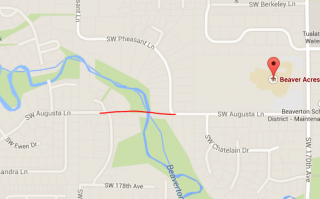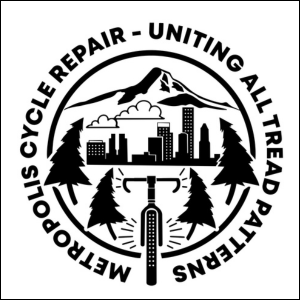
(Main image: Google Maps)
If we’ve been writing more than usual lately about the county to Portland’s west, it’s because they’ve got a lot of things going.
As the Oregonian reported Monday, the county is seeking Metro grant funding to help build a $1.5 million, 550-foot bridge across Beaverton Creek in Aloha.
The proposed bridge would both have big benefits to its immediate surroundings and fit into a rapidly improving bike network in the area. Here’s the Oregonian’s Dana Tims on the hyperlocal benefits:
A new bike and pedestrian bridge spanning Beaverton Creek could create a safe, direct new route for children in more than 900 houses southwest of the creek to Beaver Acres Elementary School.
Planners say the proposed bridge would cut the distance to school for many of those students from 1.5 miles to less than one-half mile. It would also create access to two MAX light rail stations for 2,000 residents living southwest of Beaverton Creek.
In addition, it would also provide access to five miles of trails at nearby Tualatin Hills Nature Park without having to walk along Southwest 170th Avenue, which whirs with fast-moving traffic, but has no sidewalks.
“This project really jumped off the map,” said Steve Szigethy, the county’s principal transportation planner. “It bridges a huge divide.”
Advertisement
On the larger scale, this project would create a new side-street connection between the 185th Avenue bike lane that (as we reported last week) will hopefully be improved across Tualatin Valley Highway and the proposed protected and buffered bike lanes on 170th Avenue and Merlo Road that (as we reported the week before) connects to the area surrounding Nike’s campus.
As we reported in November, road widenings in the immediate Nike area may also include protected bike lanes.
The “Nature in Neighborhoods” grant program that would put up $461,700 of the proposed bridge’s cost is paid for by a regional property tax levy approved by voters in 2013. It’s already been used to help build several bike-related projects, mostly trails with nature and wildlife components, around the metro area.
This project is among more than $4 million of applications competing for $2.5 million from the Metro grant program this year.
Washington County’s leadership on biking issues starts at the top with Commissioner Dick Schouten (whose district covers many of these streets) and includes Land Use and Transportation Director Andrew Singleakis and Pedestrian and Bicycle Coordinator Shelley Oylear as well as Szigethy. It’s exciting to see the county making so much progress.
The county has a long way to go and won’t truly escape its auto-dependent legacy until it readjusts its core priorities. But its cities are also undergoing a fairly clear cultural shift toward low-car life. If the county and its cities keep feeding that trend with better streets, the payoff could be spectacular.

